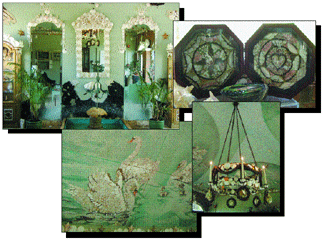Shell Station

The Headley-Whitney Museum is a silent pillar in the Lexington art community. It has been a consistent artistic staple, offering unique traveling exhibitions as well as resident collections worth revisiting from time to time.
On the outside, its practical appearance is typical of a museum this size. Nothing pretentious to turn off those taking a scenic driving tour near its home on Old Frankfort Pike.
 So you pull into the entrance, park your car, and walk into the main building. They take your admission and turn you loose, reminding you not to miss the Shell Grotto. The shell what? "Grottos are more prevalent in the Midwest, so they're a little overwhelming for some here," said Lori Dumm, the PR and marketing director for the museum.
So you pull into the entrance, park your car, and walk into the main building. They take your admission and turn you loose, reminding you not to miss the Shell Grotto. The shell what? "Grottos are more prevalent in the Midwest, so they're a little overwhelming for some here," said Lori Dumm, the PR and marketing director for the museum.
Located in museum founder George W. Headley's redesigned three-car garage, the grotto is literally a shell of its former self. Honestly, it's like nothing else you've seen in Lexington, which could be a good thing or bad thing, depending on your point of view. "It evokes a love/hate relationship," said Rachel Hooper, the audience and member services coordinator at the Headley-Whitney. "You either love it or you hate it."
And as soon as you open the door to the Shell Grotto, standing on a shell-lined walkway, you'll understand why this place evokes such a strong opinion from its guests. There are shells of all shapes and sizes as far as the eye can see. It's like the Willy Wonka of the shell world; Wonka had his chocolate, Headley had his shells.
It is safe to say that Headley was an eccentric. Who else do you know who has shell mosaics on his ceiling or a shell-encrusted decorative birdcage. But you have to give him one thing-when he set his mind to something, he went all the way! For nearly a year, Headley and friends created this fantasy pavilion, gluing thousands of commercially available shells and polished stones to the walls, doors, window moldings-whatever they could get their hands on. Even the floors are made of coral slabs from the Florida Keys.
Legend has it that even some of the shells Headley used were illegal at the time; he purchased and brought these non-native shells into the country from his travels.
The inspiration behind Headley's elaborate grotto came from the architectural precedents of 17th- and 18th-century France, England, and Italy. Grottos in these countries were mainly fashioned for the aristocracy, which appealed to Headley's fondness for things European.
So, he came back to Lexington and created his own version on the grounds of La Belle Farm in 1973, where he held social events or used it as an escape from the main residence. Today, it still houses a variety of unique show pieces. On the ceiling hangs a chandelier bedecked in shells, looking as if it had just recently been dragged straight out of the sea.
Across the room sets two intriguing pieces known as "sailor's valentines." Made in Barbados in the 19th century, sailors would send these valentines back to their betrothed while they were at sea.
Another find Headley brought back to his grotto was a giant turtle shell, no doubt already vacated or willingly donated by its former owner.
Inside the Shell Grotto are specimens from Africa, Australia, Asia, South America, and North America. There are conch shells; fossil fish; two model boats made out of shells; a butterfly made of shells; an ever-so-slightly creepy bust of Aphrodite, the goddess of beauty, made out of shells; shell frames; a chest of drawers laden with shells; a shell armoire featuring, what else, shells. I could go on and on, but you get the picture. Or maybe you don't. Perhaps the Shell Grotto is something you have to see to believe.
And whether you love it or hate it, you are never going to forget it, which is really the true art behind this grotto.
Julie Wilson's column rotates regularly on Ace's Real Estate page with Walter Jowers' Helter Shelter. If you have a fascinating residential or commercial space for Julie to profile (as long as it is not on the market), email her at jwilson@aceweekly.com.